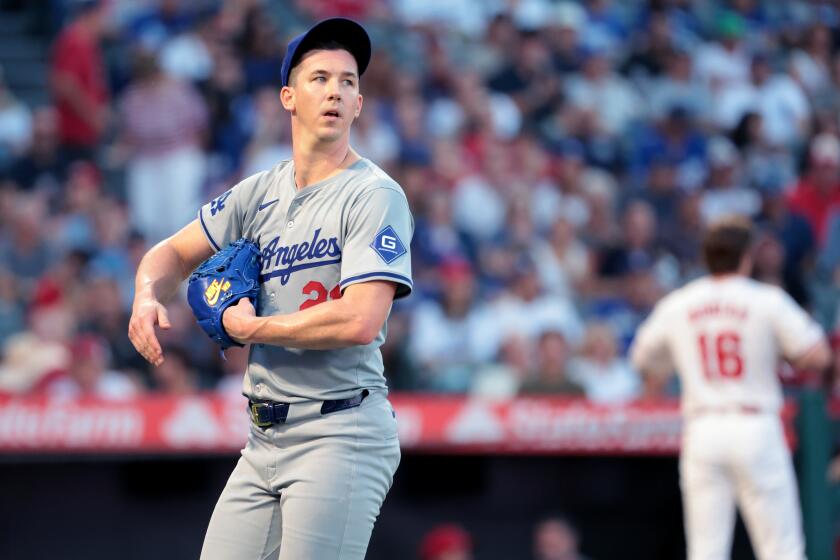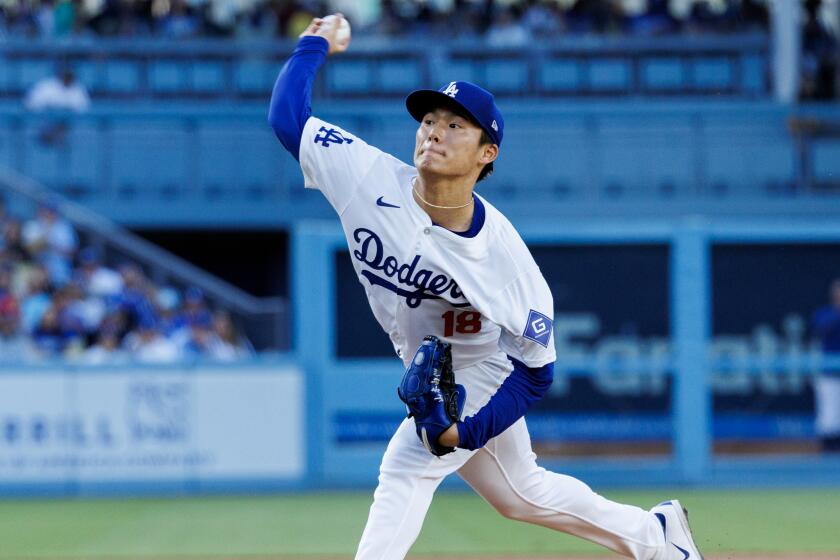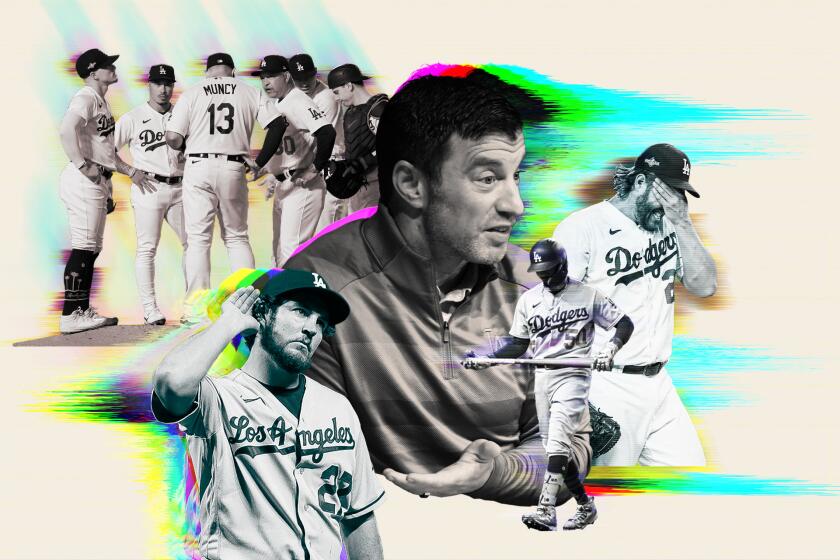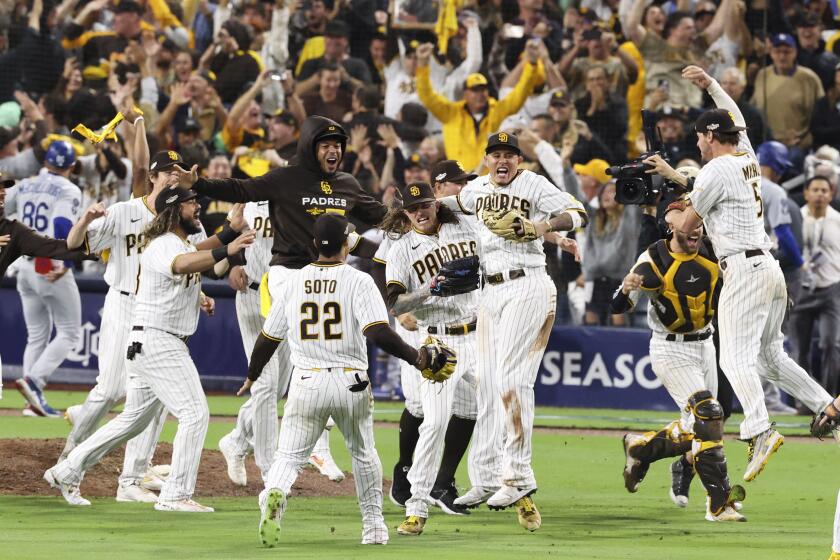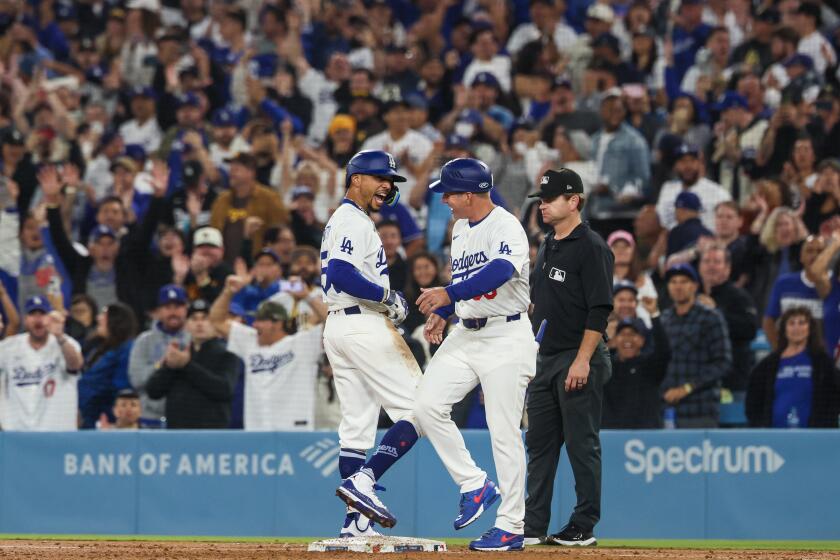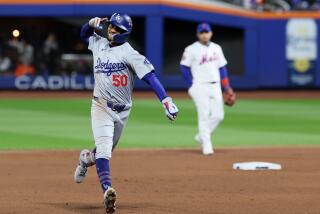
- Share via
Four times last year, the Dodgers saw Arizona Diamondbacks starter Merrill Kelly in the regular season.
On almost every occasion, they had their way with the veteran right-hander.
That was why, despite all the roster issues the team faced entering last postseason, the Dodgers still had optimism in the National League Division Series. After all, they were facing Kelly in Game 1. They had won all four meetings against him earlier that season. And they were confident that, despite their pitching problems, their lineup’s production could compensate at the plate.
But then, Kelly adapted, pitching the Dodgers much differently than he had in the past.
The Dodgers’ move to have Yoshinobu Yamamoto start Game 1 of the NLDS against the Padres shows how vulnerable the team is to another early playoff exit.
Instead of leaning on his signature changeup, he bullied hitters with cutters and fastballs. He dealt the Dodgers an unexpected game plan, then cruised through six shutout innings when they failed to effectively react.
This has been a common theme of the Dodgers’ recent postseason failings, when high-powered lineups have sputtered in surprise playoff eliminations.
Too often, the club seemingly struggles to adjust to well-crafted (and sometimes unpredictable) opposing October pitching plans — a characterization even manager Dave Roberts didn’t outright dispute Wednesday, three days before this year’s postseason opener Saturday against the San Diego Padres.
“You have to be able to read and react,” Roberts said. “You have to be in the moment and make adjustments to what they’re trying to do.”
And why, come the playoffs, haven’t the Dodgers done so more consistently?
“I don’t know the answer,” he said. “I do think that we were slow moving.”
Last year, Kelly epitomized that dilemma, spearheading a three-game sweep in which the Dodgers were constantly challenged with fastballs from Diamondbacks pitchers — who were afforded such leeway while playing with big leads throughout the NLDS — without ever managing to consistently punish them.

The Dodgers are back in the playoffs. But for how long is the big question.
“You can see we were getting beat with the fastball,” Roberts said, “and we didn’t make that adjustment.”
Go back to 2022, when the Dodgers and Padres last met in the postseason, and some rival evaluators noticed a similar dynamic.
That year, the Padres starting staff largely stayed on script, but their relievers appeared to lean more than normal on breaking pitches, holding the Dodgers to just one total run in 16 bullpen innings in the process.
“Everyone’s always doing something or trying to get some kind of edge,” said hitting coach Aaron Bates, who is in his second season in the role alongside Robert Van Scoyoc. “They’re basically playing a chess match.”
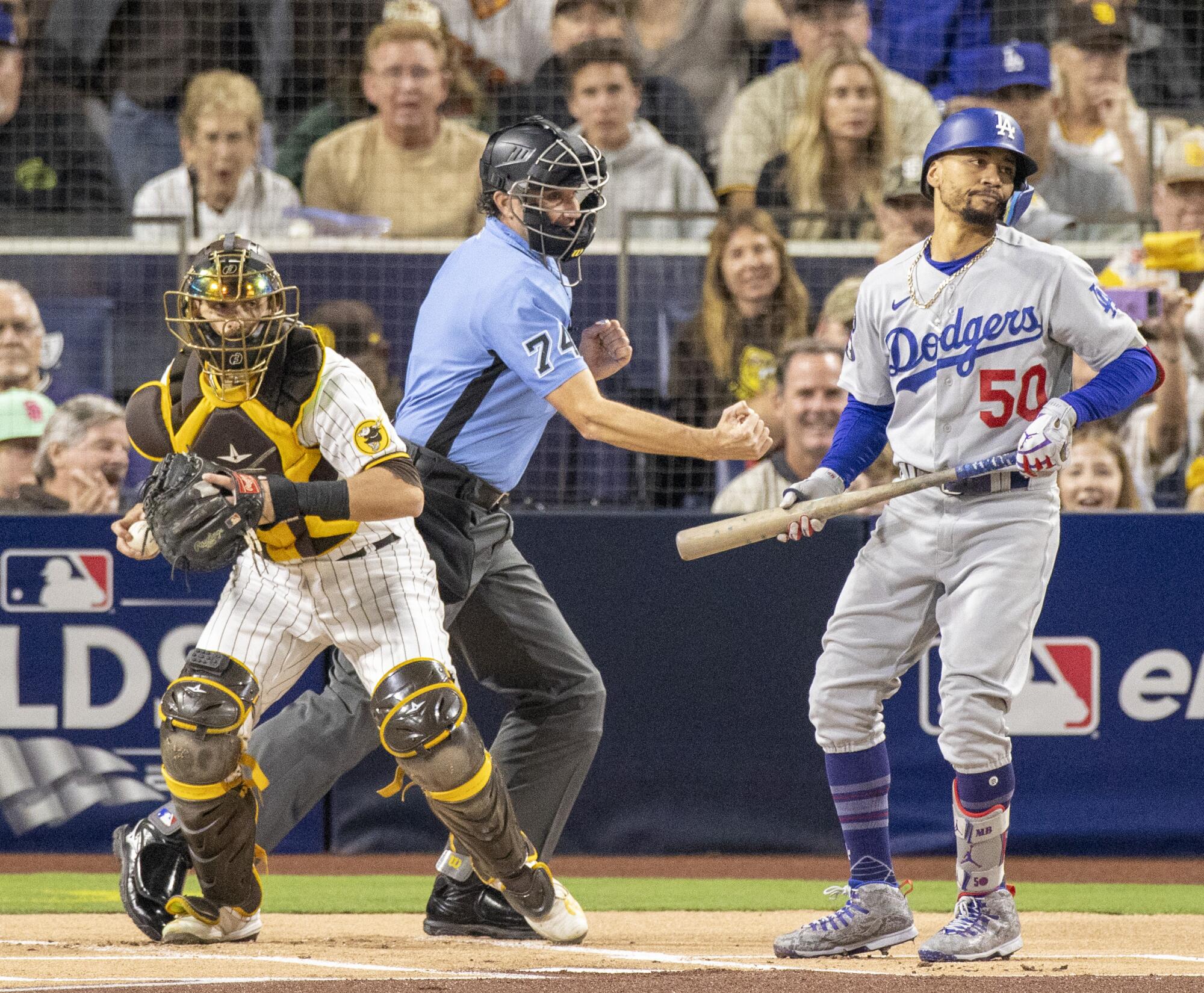
Even in 2021, the Atlanta Braves went heavy on changeups in their NL Championship Series triumph over the then-defending champion Dodgers.
And looking back now, it’s become a confounding issue the club is trying to address.
“That’s what Robert and Bates and [assistant hitting coach] JT Watkins are going to be diving in on and messaging,” general manager Brandon Gomes said. “Learning from what we’ve seen in the past and how we expect teams to attack us, and make sure that we’re the ones attacking the pitcher and not the other way around.”
The irony is, offensive game-planning has been a strength for the Dodgers during regular seasons.
In recent years, the club has fielded selective lineups that wear down opposing starters, almost always ranking near the bottom of the majors in swing percentage (they were 22nd this year) and chase rate (only the Yankees swung at pitches outside the zone less often this season).
They’ve become known for working good counts and waiting for hittable pitches, posting the third-best ratio of home runs to strikeouts (for every 5.9 times they strike out, they hit one deep) since 2021.
The Dodgers will start Yoshinobu Yamamoto in Game 1 of the NLDS against the Padres instead of Jack Flaherty in an effort to give them more flexibility.
Come October, however, those numbers get flipped on their head.
Sometimes, their strikeout rate will skyrocket (in 2022, it went from 22% in the regular season to 29.5% against the Padres in the NLDS). Or their power numbers will fizzle (in 2021, a .429 slugging percentage in the regular season slipped to .392 in the playoffs). Or their batting average will crater (last year, they hit .177 in their three playoff games compared with .257 during the year).
In each of those years, their situational hitting has also suffered, with the team batting just .212 with runners in scoring position over the last three postseasons.
Some regression is to be expected, of course. Playoff teams almost always possess better pitching than an average regular-season foe. There isn’t as much value in grinding down starters, either, with a string of talented relief arms usually beckoning in the bullpen.
A postseason environment also allows for more detailed game-planning and preparation by an opponent — a facet of the sport that has only grown in importance in the modern analytical age.
“I think game-planning in general has really taken a step forward, with more teams spending a lot of time on it, trying to expose hitter weaknesses,” Gomes said. “I think across the league and industry, we’ve seen an uptick.”
Still, as one rival evaluator noted of the Dodgers after last year’s elimination, “When it’s June 17 and the other team has just flown cross-country and is playing their 19th game in 20 days, nobody can match them.”
In the playoffs, however, the scales balance out. And the team’s results have been an entirely different story.
“We’ve gone into the 2022 and 2023 playoffs with really good offensive teams,” president of baseball operations Andrew Friedman said, “and have way underperformed.”
After winning the 2020 World Series, the Dodgers looked poised to win more championships. But myriad issues have grounded the team short of another championship.
The search for answers has yielded several different theories.
Third baseman Max Muncy said last year that the team looked at whether it’s been too passive at the plate in the playoffs.
“The teams that are making it to the World Series, they’re going up there and they’re getting their swings off,” Muncy told Foul Territory last October, “whereas we’re being too disciplined.”
There is also the simple need to clobber fastballs more consistently, a weakness that has plagued the Dodgers in each of the last three postseasons (since 2021, they are batting just .195 against four-seamers in the playoffs) and was a problem at times for this year’s club as well, despite the team still ranking top-10 in fastball batting average by the end of the season.
“We have done a lot of damage over the years on fastballs [in the regular season],” Friedman said. “And in the playoffs, we just haven’t.”
To that end, the Padres pose an interesting challenge. Their starting staff threw four-seamers only 27.2% of the time this year, the sixth-lowest rate in the majors. But their cast of hard-throwing relievers dialed up heaters on more than 36% of their pitches, the fourth-highest rate of any MLB bullpen.
The Dodgers are looking forward to playing the Padres in the NLDS as they try to avenge their stunning playoff loss to San Diego in 2022.
The Dodgers grappled with that trend during the regular season, going just 5-8 in 13 meetings against the Padres while averaging only 4.3 runs per game.
But the real intrigue now is whether San Diego sticks with that approach in the NLDS, or alters their game plan to combat the Dodgers’ familiarity with their staff.
“It definitely brings on an element of chess,” Friedman said, noting the Dodgers face similar decisions in how they pitch the Padres. “Do you change things up? How are they going to approach it? I think there are some strategic elements to that that kind of vary pitcher by pitcher, matchup by matchup.”
Bates said the Dodgers aren’t making drastic changes to their process entering these playoffs.
They’ll still craft game plans in daily afternoon hitters meetings. They’ll still look for broad tendencies and specific pitches to do damage against. They’ll trade observations in the dugout during games, deciding on-the-fly if any adjustments are necessary.
“If you’re not learning from each year, each at-bat, then you’re being foolish,” Bates said. “But I don’t think that means you necessarily do something different either. It just depends on a case-by-case basis.”
The Dodgers’ Mookie Betts might not be entering the playoffs with his hottest swing. But he’s been freed from some of the stresses he carried into previous postseasons.
Other factors are working in the Dodgers’ favor. This October, they have Shohei Ohtani at the top of their batting order. And despite Freddie Freeman’s uncertain status battling a sprained ankle, their lineup possesses strong depth, thanks to late-season surges from Mookie Betts, Teoscar Hernández, Will Smith and others.
“I would say this lineup is probably the best we’ve had,” Roberts said. “When everyone’s right, I think we’re very good versus left, versus right. There’s an on-base, there’s a slug component. There’s a bat-to-ball component. I think that it’s very well-balanced.”
The challenge will be not getting unsteadied by meticulously curated opposing pitching plans. In recent years, it’s been a defining subplot of the Dodgers’ struggles in the playoffs. And this October, it’s likely to loom large again in their World Series chances.
“It’s one of those things where you’ve got to keep adding on and scoring runs,” Bates said, “and putting pressure on the other team.”
More to Read
Are you a true-blue fan?
Get our Dodgers Dugout newsletter for insights, news and much more.
You may occasionally receive promotional content from the Los Angeles Times.

